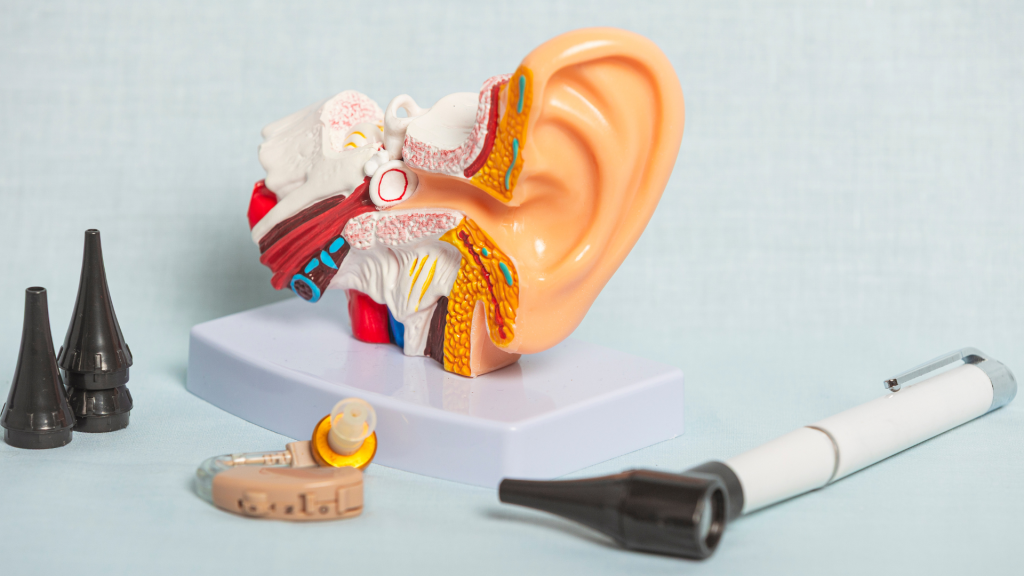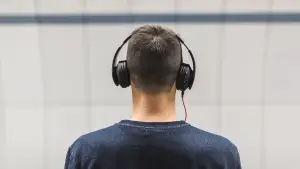For many people with hearing loss, traditional hearing aids provide the clarity and amplification needed to stay connected. But for others—especially those with conductive hearing loss, single-sided deafness (SSD), or chronic ear infections—standard hearing aids may not be effective or comfortable. That’s where bone-anchored hearing aids (BAHA) come in.
A BAHA is a specialized hearing system that uses bone conduction to transmit sound directly to the inner ear, bypassing damaged parts of the outer or middle ear. Instead of amplifying sound through the ear canal, BAHA devices deliver vibrations through the skull to stimulate hearing. This innovative approach can offer clearer sound and improved speech understanding for people who haven’t found success with conventional solutions.
Whether you’re just beginning to explore hearing loss treatments or have been referred for a BAHA evaluation, understanding how this device works can help you make an informed decision. In this guide, we’ll explain what a BAHA is, how it functions, who can benefit from it, and what the implant process involves.
What Is a BAHA?
A BAHA, or bone-anchored hearing aid, is an implantable hearing system that uses bone conduction to deliver sound directly to the inner ear. Unlike traditional hearing aids that amplify sound through the air and into the ear canal, a BAHA bypasses the outer and middle ear entirely. This makes it an excellent option for individuals who cannot use standard hearing aids due to ear canal problems, chronic infections, or anatomical abnormalities.
Key Components of a BAHA System
A BAHA consists of three main parts:
- The Implant: A small titanium post surgically placed in the bone behind the ear. It integrates with the skull over time through a process called osseointegration.
- The Abutment or Magnetic Connector: This connects the external sound processor to the implant. Some systems use a visible abutment, while others use a magnetic attachment hidden beneath the skin.
- The Sound Processor: This external component captures sound from the environment, converts it into vibrations, and transmits those vibrations through the implant to the skull and inner ear.
Types of Hearing Loss BAHA Can Address
BAHA systems are primarily designed for people with:
- Conductive hearing loss: Where sound cannot pass efficiently through the outer or middle ear.
- Mixed hearing loss: A combination of conductive and sensorineural hearing loss.
- Single-sided deafness (SSD): Where one ear has profound hearing loss while the other hears normally.
By bypassing the damaged or non-functioning parts of the ear, the BAHA delivers sound directly to the functioning cochlea, providing a clearer, more natural listening experience.
BAHA vs. Traditional Hearing Aids
Here’s how BAHA devices differ from standard hearing aids:
| Feature | Traditional Hearing Aids | BAHA Devices |
|---|---|---|
| Sound Path | Through the ear canal | Through bone to the inner ear |
| Suitable for Ear Infections | No | Yes |
| Used for SSD | Limited | Highly effective |
| Requires Open Ear Canal | Yes | No |
This unique approach makes BAHA systems an effective and comfortable alternative for many people who can’t benefit from or tolerate traditional hearing aids.
How Does a BAHA Work? Understanding Bone Conduction
The BAHA system is built on a fascinating principle of human biology: bone conduction. While we normally think of hearing as something that happens through our ears, the inner ear—the cochlea—can actually detect sound vibrations that travel through the bones of the skull. BAHA technology harnesses this natural ability to deliver sound in a completely different way.
The Science Behind Bone Conduction
In a healthy auditory system, sound travels through the air, enters the ear canal, vibrates the eardrum, and moves through the middle ear bones to reach the cochlea. However, when there’s a problem in the outer or middle ear—such as a blockage, infection, or malformation—this pathway is disrupted. Bone conduction bypasses these structures entirely.
A BAHA device uses the bones of the skull to conduct sound vibrations directly to the inner ear, where they are interpreted as sound by the auditory nerve and the brain.
How BAHA Devices Transmit Sound
Here’s a step-by-step look at how a BAHA system works:
- Sound Collection: The external sound processor, which looks similar to a small behind-the-ear hearing aid, picks up sound from the environment.
- Vibration Conversion: The processor converts these sounds into mechanical vibrations.
- Vibration Transmission: These vibrations are transmitted to the titanium implant that has been surgically embedded in the skull bone, or through a magnetic interface beneath the skin.
- Bone Conduction: The vibrations travel through the skull bone to the cochlea (inner ear), bypassing the outer and middle ear entirely.
- Auditory Perception: The cochlea processes the vibrations just like it would with sounds coming through the ear canal, sending signals to the brain where they’re interpreted as sound.
Open-Ear Advantage
Because BAHA doesn’t rely on the ear canal, it provides a significant benefit for people who have chronic ear infections or cannot wear traditional hearing aids. The ear canal remains open and unobstructed, reducing moisture buildup and irritation.
This “open-ear” advantage not only improves comfort but also enhances sound clarity, particularly in noisy environments, because the device focuses sound transmission through direct bone stimulation rather than air conduction.
Directional Hearing and BAHA for SSD
In cases of single-sided deafness (SSD), BAHA offers a unique advantage. The processor on the deaf side picks up sound and transmits it via bone conduction to the functioning cochlea on the opposite side. This helps restore spatial awareness and sound localization, which are often impaired in people with SSD.
The BAHA Implant Process: What to Expect
For those considering a bone-anchored hearing aid, understanding the implantation process is essential. While the idea of surgery can be intimidating, the BAHA procedure is generally straightforward and well-tolerated. This section outlines the typical steps involved—from evaluation to activation.
Step 1: Evaluation and Candidacy
Before proceeding with a BAHA, you’ll undergo a comprehensive hearing evaluation with an audiologist and possibly an ENT (ear, nose, and throat) specialist. They’ll assess:
- The type and degree of hearing loss
- Your hearing history and medical background
- Ear anatomy and bone density
- Your experience (if any) with conventional hearing aids
If you’re a candidate, you may be offered a trial with a BAHA processor on a soft band or test rod. This non-surgical trial allows you to experience the benefits of bone conduction before deciding on implantation.
Step 2: Surgical Implantation
The actual BAHA surgery is a same-day outpatient procedure, typically done under local or general anesthesia, depending on the patient’s needs and age.
The surgeon makes a small incision behind the ear to:
- Insert a titanium implant into the bone
- (For abutment-based systems) attach a small external post through the skin
- (For magnetic systems) place an internal magnet beneath the skin
The procedure usually takes 30–60 minutes, and patients are allowed to return home the same day.
Step 3: Healing and Osseointegration
After surgery, there is a healing period of several weeks (typically 3–6 weeks) to allow for osseointegration—where the titanium implant fuses with the surrounding bone. This fusion is crucial for the stability and function of the device.
During this time:
- Patients may need to clean the surgical site daily.
- Follow-up visits help monitor healing and prevent infection.
- In children or those with thinner skin, healing may take slightly longer.
Step 4: Processor Activation and Fitting
Once healing is complete, the external sound processor is attached and activated. During this appointment:
- The audiologist programs the device to suit your specific hearing profile.
- You’ll learn how to use, clean, and maintain the processor.
- Volume and frequency settings are adjusted based on real-time feedback.
This is the point when many patients hear through the BAHA system for the first time—and the experience can be both exciting and emotional.
Step 5: Ongoing Support and Adjustments
As with any hearing device, follow-up care is important. You’ll need periodic check-ins to:
- Fine-tune the settings for comfort and clarity
- Monitor the implant site (especially in the early months)
- Address any device-related issues
With proper care, BAHA devices can last for many years, improving communication, confidence, and quality of life.
Benefits and Limitations of BAHA Devices
Bone-anchored hearing aids (BAHA) offer a powerful and often life-changing alternative for individuals who can’t benefit from traditional hearing aids. Like any medical device, however, they come with both strengths and limitations. Understanding these can help you make an informed decision about whether BAHA is right for you or your loved one.
Benefits of BAHA Systems
1. Bypasses Damaged Ear Structures
BAHA devices transmit sound directly to the inner ear via bone conduction, making them ideal for individuals with:
- Chronic outer or middle ear infections
- Congenital ear malformations (e.g., atresia or microtia)
- Ossicular chain dysfunction
- Single-sided deafness (SSD)
2. Open-Ear Comfort
Because BAHA systems don’t sit inside the ear canal, they allow the ear to remain open and well-ventilated. This reduces:
- Ear canal irritation
- Moisture buildup
- Risk of infection
3. Improved Sound Clarity and Localization
BAHA often delivers clearer sound, especially for those with conductive loss, and can improve spatial awareness in SSD patients by restoring perception of sound direction.
4. Fewer Feedback Issues
Traditional hearing aids can sometimes cause audio feedback, especially when amplifying sound in damaged ear canals. Since BAHA bypasses the ear canal, it often avoids this problem altogether.
5. Long-Term Solution
Once implanted and healed, BAHA devices typically offer stable and lasting results, with minimal long-term maintenance required aside from cleaning and processor updates.
Limitations and Considerations
1. Requires Surgery
BAHA implantation involves a minor surgical procedure, which—though low risk—may not be suitable for everyone, particularly those with:
- Bleeding disorders
- Poor bone quality
- Certain skin conditions
2. Not for All Types of Hearing Loss
BAHA is primarily designed for conductive, mixed hearing loss and SSD. It is not appropriate for individuals with bilateral sensorineural hearing loss, who may benefit more from conventional hearing aids or cochlear implants.
3. Healing Time and Care
Post-surgical care is required to ensure proper healing and osseointegration. In some cases, skin irritation or infection can occur at the implant site, particularly with abutment systems.
4. Visibility and Cosmetics
While newer models are more discreet—especially magnetic systems—some users may be concerned about the visibility of the device, particularly the external processor and abutment.
5. Cost and Insurance
BAHA systems and their implantation can be expensive. Coverage varies widely depending on location and insurance provider. Some plans cover both the device and surgery, while others may only partially reimburse costs.
Conclusion
Bone-anchored hearing aids (BAHA) represent a remarkable advancement in hearing technology, offering a lifeline to those who cannot benefit from traditional hearing aids. By bypassing the outer and middle ear and directly stimulating the cochlea through bone conduction, BAHA systems provide clearer, more consistent sound for individuals with conductive hearing loss, mixed hearing loss, or single-sided deafness.
What sets BAHA apart is not just how it delivers sound, but the real-world impact it can have—restoring the ability to engage in conversations, enjoy music, hear important sounds in the environment, and fully participate in daily life. For many, the change is transformative.
That said, choosing a BAHA system is a decision that should be made with care. It requires surgical implantation, commitment to follow-up care, and realistic expectations about outcomes. Fortunately, a trial period with a non-surgical BAHA processor can help you evaluate its benefits before proceeding with implantation.
If you or a loved one are struggling with hearing loss and have not found success with standard hearing aids, talk to your audiologist or ENT specialist about BAHA. With the right evaluation and support, it could be the solution that reconnects you to the world of sound.
FAQ
Who is a good candidate for a BAHA?
Candidates typically include individuals with conductive or mixed hearing loss, single-sided deafness (SSD), or those who cannot tolerate traditional hearing aids due to chronic ear infections or anatomical issues. A hearing care professional will perform a detailed evaluation to determine eligibility.
Is the BAHA surgery painful or risky?
BAHA implantation is a minimally invasive outpatient procedure with a relatively low risk of complications. Most people experience mild discomfort for a few days post-surgery, and recovery is generally quick. As with any surgery, there’s a small risk of infection or implant-related issues.
How soon after surgery can the BAHA be used?
After the implant surgery, there is typically a healing period of 3–6 weeks to allow the implant to fuse with the bone (osseointegration). Once healed, the external sound processor can be attached and activated by your audiologist.
Can children use BAHA devices?
Yes, BAHA devices are FDA-approved for children. For very young children or those not yet ready for surgery, the processor can be worn on a soft band until they are old enough for implantation. Early intervention often leads to better hearing and language outcomes.
Will insurance cover the cost of a BAHA?
Insurance coverage varies. Many providers—including Medicare and Medicaid in certain regions—may cover the device, surgery, and follow-up care, especially if the BAHA is deemed medically necessary. It’s important to check with your insurance and work with your hearing care provider to verify coverage.
Disclaimer
This article is for informational purposes only and is not a substitute for professional medical advice, diagnosis, or treatment. If you are concerned about your hearing or ear health, please consult a qualified healthcare provider.






